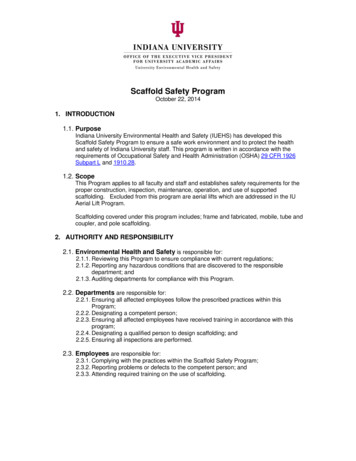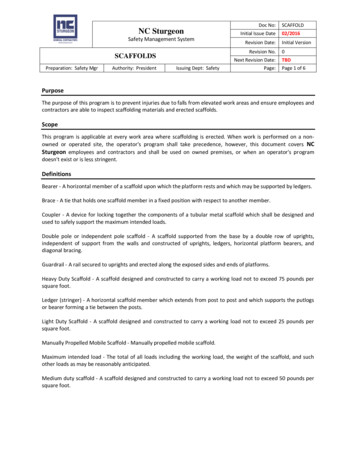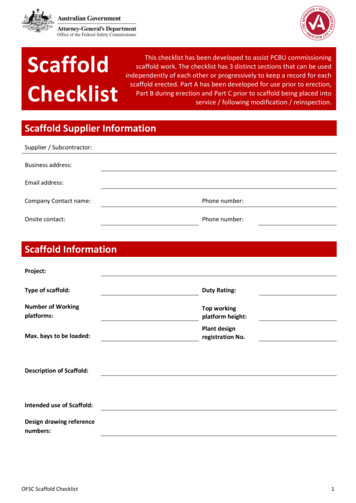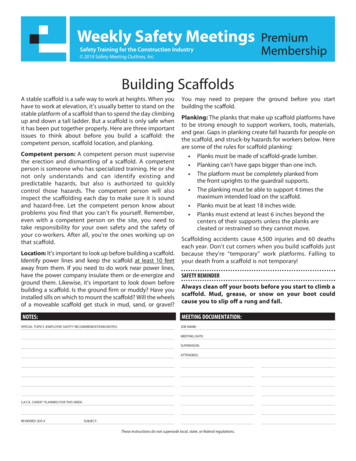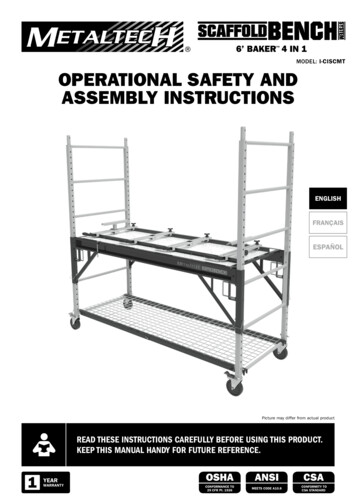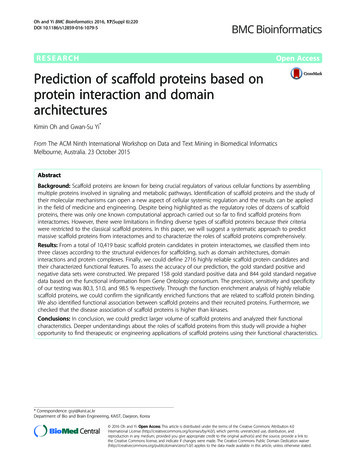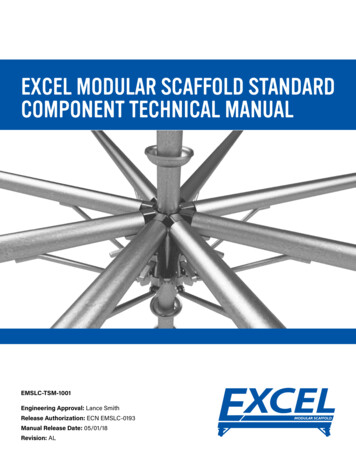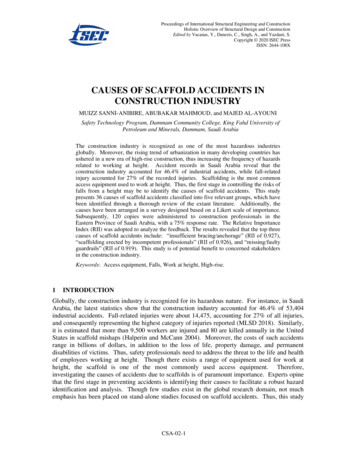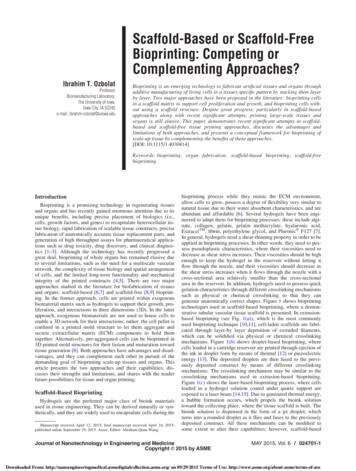
Transcription
Scaffold-Based or Scaffold-FreeBioprinting: Competing orComplementing Approaches?Ibrahim T. OzbolatProfessorBiomanufacturing Laboratory,The University of Iowa,Iowa City, IA 52242e-mail: ibrahim-ozbolat@uiowa.eduBioprinting is an emerging technology to fabricate artificial tissues and organs throughadditive manufacturing of living cells in a tissues-specific pattern by stacking them layerby layer. Two major approaches have been proposed in the literature: bioprinting cellsin a scaffold matrix to support cell proliferation and growth, and bioprinting cells without using a scaffold structure. Despite great progress, particularly in scaffold-basedapproaches along with recent significant attempts, printing large-scale tissues andorgans is still elusive. This paper demonstrates recent significant attempts in scaffoldbased and scaffold-free tissue printing approaches, discusses the advantages andlimitations of both approaches, and presents a conceptual framework for bioprinting ofscale-up tissue by complementing the benefits of these approaches.[DOI: 10.1115/1.4030414]Keywords: bioprinting, organ fabrication, scaffold-based bioprinting, scaffold-freebioprintingIntroductionBioprinting is a promising technology in regenerating tissuesand organs and has recently gained enormous attention due to itsunique benefits, including precise placement of biologics (i.e.,cells, growth factors, and genes) to recapitulate heterocellular tissue biology, rapid fabrication of scalable tissue constructs, precisefabrication of anatomically accurate tissue replacement parts, andgeneration of high throughput assays for pharmaceutical applications such as drug toxicity, drug discovery, and clinical diagnostics [1–3]. Although the technology has recently progressed agreat deal, bioprinting of whole organs has remained elusive dueto several limitations, such as the need for a multiscale vascularnetwork, the complexity of tissue biology and spatial arrangementof cells, and the limited long-term functionality and mechanicalintegrity of the printed constructs [4,5]. There are two majorapproaches studied in the literature for biofabrication of tissuesand organs: scaffold-based [6,7] and scaffold-free [8,9] bioprinting. In the former approach, cells are printed within exogenousbiomaterial matrix such as hydrogels to support their growth, proliferation, and interactions in three dimensions (3D). In the latterapproach, exogenous biomaterials are not used to house cells toenable a 3D network for their interactions; rather, the cell pellet isconfined in a printed mold structure to let them aggregate andsecrete extracellular matrix (ECM) components to hold themtogether. Alternatively, pre-aggregated cells can be bioprinted in3D printed mold structures for their fusion and maturation towardtissue generation [8]. Both approaches have advantages and disadvantages, and they can complement each other in pursuit of thedemanding goal of bioprinting scale-up tissues and organs. Thisarticle presents the two approaches and their capabilities, discusses their strengths and limitations, and shares with the readerfuture possibilities for tissue and organ printing.Scaffold-Based BioprintingHydrogels are the preferred major class of bioink materialsused in tissue engineering. They can be derived naturally or synthetically, and they are widely used to encapsulate cells during theManuscript received April 12, 2015; final manuscript received April 16, 2015;published online September 29, 2015. Assoc. Editor: Abraham Quan Wang.bioprinting process while they mimic the ECM environment,allow cells to grow, possess a degree of flexibility very similar tonatural tissue due to their water absorbent characteristics, and areabundant and affordable [6]. Several hydrogels have been engineered to adapt them for bioprinting processes: these include alginate, collagen, gelatin, gelatin methacrylate, hyaluronic acid,ExtracelTM, fibrin, polyethylene glycol, and PluronicV F127 [7].In general, hydrogels need a shear-thinning property in order to beapplied in bioprinting processes. In other words, they need to possess pseudoplastic characteristics, where their viscosities need todecrease as shear stress increases. Their viscosities should be highenough to keep the hydrogel in the reservoir without letting itflow through the nozzle, and their viscosities should decrease asthe shear stress increases when it flows through the nozzle with across-sectional area relatively smaller than the cross-sectionalarea in the reservoir. In addition, hydrogels need to possess quickgelation characteristics through different crosslinking mechanismssuch as physical or chemical crosslinking so that they cangenerate anatomically correct shapes. Figure 1 shows bioprintingtechnologies used in scaffold-based bioprinting, where a demonstrative tubular vascular tissue scaffold is presented. In extrusionbased bioprinting (see Fig. 1(a)), which is the most commonlyused bioprinting technique [10,11], cell-laden scaffolds are fabricated through layer-by layer deposition of extruded filaments,which can be solidified via physical or chemical crosslinkingmechanisms. Figure 1(b) shows droplet-based bioprinting, wherecells loaded in a cartridge reservoir are printed through ejection ofthe ink in droplet form by means of thermal [12] or piezoelectricenergy [13]. The deposited droplets are then fused to the previously deposited construct by means of different crosslinkingmechanisms. The crosslinking mechanism may be similar to thecrosslinking mechanisms used in extrusion-based bioprinting.Figure 1(c) shows the laser-based bioprinting process, where cellsloaded in a hydrogel solution coated under quartz support areexposed to a laser beam [14,15]. Due to generated thermal energy,a bubble formation occurs, which propels the bioink solutiontoward the collecting place, where the tissue scaffold is built. Thebioink solution is dispensed in the form of a jet droplet, whichturns into a rounded droplet as it flies and fuses to the previouslydeposited construct. All these mechanisms can be modified tosome extent to alter their capabilities; however, scaffold-basedJournal of Nanotechnology in Engineering and MedicineC 2015 by ASMECopyright VRMAY 2015, Vol. 6 / 024701-1Downloaded From: n.asme.org/ on 09/29/2015 Terms of Use: http://www.asme.org/about-asme/terms-of-use
Fig. 1 Scaffold-based and scaffold-free bioprinting technologies: (a) extrusion-based bioprinting, (b) droplet-based bioprinting, (c) laser-based bioprinting, (d) bioprinting tissue spheroids, and (e) bioprinting cell pelletbioprinting techniques in general enable deposition ease and practicality for tissue fabrication.In addition to direct encapsulation of cells in hydrogels duringbioprinting processes, microcarriers have been used as reinforcement blocks, where cells can be loaded in microcarriers indifferent geometries (spherical, in general [16]) with porous architecture. When cells are cultured on them, they allow the cells toquickly proliferate. Cultured cells in microcarriers can then beprinted in a delivery medium such as hydrogel. It was demonstrated in a recent study that cells can interact and aggregate betterinside the microcarriers than can cells loaded in the hydrogelsolution alone [17].In addition to hydrogels and microcarriers, decellularizedmatrix components that are derived from nature’s own scaffoldhave been considered as a new bioink source for advanced tissuefabrication. Taylor’s groundbreaking work in organ decellularization [18] has attracted numerous researchers in the last five yearsin regeneration of organs, which later inspired Cho and coworkers[19] to use decellularized matrix components in printing tissueanalogs. In their recent study, they decellularized tissues andchopped them into smaller fragments, which were then loadedwith cells and printed with a poly-caprolactone frame to supportthe tissue analogs. The approach seems to have a great benefit toward biomimetic tissue and organ printing, when the decellularized proteins (such as collagen, hyaluronic acid, etc.) can be tuned024701-2 / Vol. 6, MAY 2015in a way that they can be printed in solid form directly withoutneed of a hard polymer frame for future studies.Scaffold-Free BioprintingScaffold-free bioprinting has been considered a promisingdirection in tissue fabrication because it enables recapitulatingnative tissues in a shorter period of time than the commonly usedcell-laden hydrogel approach. Instead of expecting cells to proliferate in hydrogels, one can start with considerably high cell numbers, that is, close to natural tissues, triggering them to depositECM components in a confined space per demand such as cylinder, torus, spheroids, and honeycomb [20]. The hydrogel-freenature of the biomaterials facilitates quick fusion and maturationof building blocks, where the technology has been demonstratedto fabricate cardiac patches [21], blood vessels [8], and nerve tissues [22]. Several biofabrication approaches have been describedin the literature for cell aggregates, particularly tissue spheroids.These methods include the hanging drop [23,24], pellet (re-aggregation) culture or conical tube [25], micromolding [26,27], microfluidics (hydrodynamic cell trapping) [28,29], liquid overlay [30],spinner flask [31], and rotating wall vessel techniques [32]. Itshould be noted that not all of them have been applied in fabricating spheroids for bioprinting purposes, but any of them can beconsidered as an alternative approach as long as the techniqueTransactions of the ASMEDownloaded From: n.asme.org/ on 09/29/2015 Terms of Use: http://www.asme.org/about-asme/terms-of-use
facilitates efficient and economical generation of spheroids forscale-up tissue printing activities. Not just homocellular but heterocellular examples have been demonstrated as well [33]. Prefabricated tissue spheroids are loaded in pipettes and dispensed using amechanical ram-driven extrusion-based bioprinting system in acarrier hydrogel that is inert to cell adhesion (see Fig. 1(d)). In themeantime, a mold structure is 3D printed, where the bioprintedspheroids are cast inside the mold, letting them fuse and maturateinto tissue followed by removal of the mold material. Instead ofdelivering cells in high density in aggregated mature spheroid form,delivering them directly in pellet form works more efficiently[22,34]. In that case, bioprinting cells into printed micromolds isessential to confine cells inside the molds and trigger them to aggregate in the shape of the molds (see Fig. 1(e)). Thus, two materialsneed to be deposited into the construct, where cell pellet can beprinted inside hydrogels that are inert to cell adhesion such as agarose or alginate. There is a controversy among some Scientists aboutwhen the applied molding approach should be considered a scaffold.Although the mold itself supports the tissue to grow and maturate,cells do not use mold matrix to proliferate through; thus, the appliedmold can be considered as a support structure, which is very common in traditional additive manufacturing technologies [35] used forsupporting overhangs. The major hurdle with this approach is thedifficulty of making large-scale tissues without using a temporarymolding material. Thus, tissue strands can be considered as an alternative approach to tissue printing, where long strands of tissues canbe fabricated and printed using a custom-made nozzle apparatus. Inthis case, the laborious nature of spheroid preparation and loadingcan be eliminated, and the need for printing an enclosure mold iseliminated for cell pellets. Although this approach provides theunique advantage of printing tissue strands in tandem with vasculature, increasing the size of the tissue strands or the need for neocapillarization within them can be considered as milestones on theway to generating larger-scale tissues and organs in the future [36].A Comparison: Scaffold-Based or Scaffold-FreeBioprinting?In general, cell encapsulation in biomaterials allows cell patterning that has a great potential for direct organ printing due tothe complex heterocellular composition of native tissues; however, subsequent ECM formation, digestion and degradation ofbiomaterial matrix, and proliferation of encapsulated cells are nottrivial to control. There are intrinsic limitations for scaffold-basedbioprinting due to restricted cell proliferation and colonization,while cells are immobilized within hydrogels and do not spread,stretch, and migrate to generate the new tissue successfully. Cellaggregate-based bioinks, on the other hand, have great advantagesin bioprinting. First of all, they better facilitate cellular interactions, including homocellular and heterocellular interactions,while cells are loaded with very high cell densities close to nativetissue and not immobilized in a hydrogel network. This enablesgeneration of tissue with close biomimicry and preserves the cellphenotype and functionality for longer times. In addition, tissuescan be fabricated in a very short period of time in culture conditions, which cannot be easily achieved using hydrogels. Despitethese advantages, they have several limitations. First of all, a veryhigh number of cells is needed to prepare a sufficient amount ofaggregates. These numbers can go up to a few hundred millioncells depending on the cell size and how quickly they depositECM. In general, expanding cells in these numbers is laborintensive and costly, and some cell types cannot grow quickly,which limits their applicability and availability. In addition,parenchymal cells in highly metabolic organs do not secrete manyECM components, and the resulting cell aggregates are very weakin their mechanical and structural integrity. Therefore, supportingstromal cells should be cocultured to provide enough strength forbioprinting uses. In addition to mechanical properties, the dimensional constraints are another hurdle. In general, the permeabilityof cell aggregates is lower than that of hydrogels, and the diffusion of media and oxygen is highly limited. Thus, fabrication oftissue spheroids over 500 lm can induce hypoxia, which is hardfor highly metabolic cells to survive. Resilient cells (i.e., fibroblast) or cells that like hypoxia (i.e., chondrocyte) can surpassthese limitations. Thus, neocapillarization inside the cell aggregates is highly desired for scale-up fabrication of tissues andorgans. From a bioprinting standpoint, the bioprinting of cell aggregate is highly trivial when the bioink is loaded in near-pelletform when the bioink can be in a liquid state and printed like ahydrogel-based bioink without the need for any other means. InTable 1 Comparison of scaffold-based and scaffold-free bioprintingScaffold-based bioprintingProcess capabilitiesBioink considerationEnd product acyBioprinting timeProcessing modesScaffold-free bioprintingLowLowMedium-longExtrusion-based bioprintingBioink modeBioprintabilityBioink viscosityMulticellular feasibilityAffordabilityCommercial availabilityHighHighShortExtrusion-based, droplet-based, orlaser-based bioprintingHighFeasibleHighHydrogels, microcarriers, anddecellularized matrixLiquid, sol-gel, or solidEasyLow to highYesLow cost to high costAvailableCell interactionsMechanical/structural integrityTissue regeneration timeTissue biomimicryApplicationsLimitedHighConsiderably longLow to mediumTransplantation and drug testingHighLowShortHighTransplantation and drug testingEasy to bioprint, economical, scalable, and high resolutionToxicity, degradation, and limitedcell-to-cell interactionsRapid tissue maturation andgeneration, cell-friendlyNeed for high cell numbers initially,low scalability, and weak mechanicalintegrityCell viabilityControl of single-cell printingThroughputBioink typesJournal of Nanotechnology in Engineering and MedicineMedium-highNot feasibleMediumCell pellet, tissue spheroids, andtissue strandsLiquid or solidDifficultMedium to very highYesHigh costAvailableMAY 2015, Vol. 6 / 024701-3Downloaded From: n.asme.org/ on 09/29/2015 Terms of Use: http://www.asme.org/about-asme/terms-of-use
that case, a supporting molding structure is needed for cells to aggregate, and that support structure should be printed with minimum mold cavity space; otherwise, cells pellet do not formaggregates, but rather stay as a cell suspension. For scale-up tissueprinting missions, the need for molding is thus not ideal. Whenthe aggregates are loaded in a fully or semi-aggregated form suchas tissue spheroids or strands, printing is not trivial while the bioink is in a solid state that should be transferred to the printingstage with minimum stress on the cells. Thus, hydrogels or biological oil can be used as a medium to deliver them to the bioprintingstage; however, such a medium brings an issue when it needs tobe washed out from the printed construct. Despite their greatadvantages, tissue spheroids have several challenges during bioprinting processes. First of all, cell aggregates need to be printedbefore they become fully maturated, such as in the first ten daysof cell aggregation; otherwise, maturated cell aggregates lose theirability to fuse. In addition, loading cell aggregates into the nozzle,which is a pipette, in general [8], is quite difficult. Tissue spheroids need a delivering medium to be extruded, in which case thedelivering medium will be a fugitive ink such as a thermosensitivehydrogel that is inert to cell adhesion. In addition, tissue spheroidshave quick fusion capabilities that trigger their aggregation insidethe nozzle tip and make their printability highly challenging.Upon printing, there is also a risk that tissue spheroids may notcontact each other tightly enough. This generates gap betweenspheroids, and the resulting tissue becomes leaky. Last and themost important, fabrication of a huge number of tissue spheroidsand bioprinting them in an automated way during long-durationbioprinting missions is another hurdle considering the transitionof the technology to scale-up tissue fabrication in the near future.Despite these challenges, bioprinting tissue spheroids is an exemplary means to create tissues in vitro, and further modificationshave been made on the technology.Microcarriers, on the other hand, possess bioprinting limitationssimilar to those of tissue spheroids and have shortcomings associated with degradation and related end products similar to hydrogels. Although it can be considered as an intermediate stagebetween cell aggregates and hydrogels, there are challenges thatmust be overcome in order to deploy microcarriers in bioprintingefficiently. These challenges include the difficulty of ensuringcontact between microcarriers; the degradation of the microcarrierbiomaterial and associated end products that can be toxic to cells;and the risks of clogging the nozzle tip due to the hard and adhesive nature of the microcarriers that can trigger their aggregationinside the nozzle tip.Despite the advantages of the scaffold-free bioprintingapproach in the fabrication of tissues with better biomimicry in ashorter period time, the majority of the research community prefers hydrogel-based bioink for several reasons. First of all, hydrogels are commercially available and affordable in general, andthey are abundant for bioprinting processes. Bioprinting has asteep learning curve for operators, and affordable bioink materialsare preferred for ease of use. Due to their abundance and affordability, larger tissue constructs can be manufactured both in volume and quantity, providing a great scalability feature. Inaddition, hydrogels have great shear-thinning properties, and theycan be printed through various means such as crosslinking andbioprinting mechanisms as discussed before. Besides, bioprintingin hydrogels does not require very high cell numbers to start with;cell densities in the ranges of a few millions per milliliter are sufficient to grow into larger numbers in vitro or in vivo; however,larger cell densities better support tissue growth. The scaffoldbased approach limits cell growth in long incubation periodsin vitro; however, it performs well, when the tissue constructs areimplanted while the body can degrade and absorb the scaffoldmaterial easily, triggering neovascularization through themigration of endothelial cells into the scaffold construct and thegeneration of a capillary network within them. Currently, tissueengineering approaches are also being investigated to enable thegrowth of nerves into transplanted tissues [37]. Table 1 lays out acomparison between scaffold-based and scaffold-free bioprintingconsidering a wide-array of components and performance metricsof bioprinting.The Demanding Goal: Future Perspective for OrganPrintingDespite considerable progress in the context of bioprinting inthe last decade, there is still much work remaining for wholeorgan bioprinting [1]. Scaffold-based or scaffold-free bioprintingapproaches alone do not possess the required capability to createscale-up tissues. The major challenge with the scaffold-based bioprinting approach is that parenchymal cells do not preserve theirviability, phenotypic stability, or functionality long term in vitro.Therefore, the parenchyma tissue can better grow in the scaffoldfree approach. While the scaffold-free approach does not possesssufficient mechanical stiffness, the stromal tissue of the organ canbe considered using scaffold-based bioprinting. Although there isa perception that scaffold-based and scaffold-free bioprintingcomplete with each other, they can complement each other towardthe demanding goal of larger-scale tissue and organ bioprinting.One can thus consider a combination of these two approaches,where the vascular network can be bioprinted for both perfusionand mechanical support purposes, and the parenchymal side canFig. 2 Hybrid bioprinting of scaffold-based vascular constructs in tandem with scaffold-free parenchyma tissue, where fusion,tissue remodeling, and self-assembly of tissue strands take place and sprouting can take place between the macrovascular network and capillaries in tissue strands. This concept generalizes the tissue used; however, for different tissue types, modifications on the system would be essential.024701-4 / Vol. 6, MAY 2015Transactions of the ASMEDownloaded From: n.asme.org/ on 09/29/2015 Terms of Use: http://www.asme.org/about-asme/terms-of-use
be integrated via scaffold-free bioprinting. In this case, a multiscale vascular network needs to be created to complete the scaleup tissue infrastructure. This has been recently performed usingmanual staking of cell sheet technology, where sprouting ofmicrocapillaries was performed by placing a vascular network.Figure 2 demonstrates the concept of the scale-up tissue printingprocess, where a vascular network can be printed in tandem withthe parenchymal tissue. Upon printing, scaffold-free parenchymaltissue can fuse, maturate, and self-assemble around the vasculature. Further, culturing of the tissue construct while applying idealperfusion conditions can enable the sprouting of capillaries bybridging the main vascular network with the capillary networkforming inside the parenchymal tissue.Although the scaffold-based and scaffold-free bioprintingapproaches have been studied alone, this perspective paper proposes a hybrid bioprinting concept, where they can complementeach other toward future organ printing technologies. Studieshave been done to construct perfusable cardiac tissues using a 3Dcell sheet fabrication technology, in which endothelial cells withina cardiac cell sheet sprouted and connected to the main blood vessel upon perfusion of growth-factor-rich culture media [38]. Otherstudies have also shown that a prevascularized hepatic bud, whentransplanted in vivo, can successfully anastomose to the mainblood vessel and survive for a long period of time, carrying out itsfunction [39]. In addition, a recent article [40] demonstratedvascularization of cell aggregates in tumor spheroid models androbust sprouting angiogenesis into the matrix where the aggregates were loaded, showing the great possibility of enabling anastomosis of vascular networks of two aggregates during the fusionprocess. All of these highlights offer foreseeable potential for thehybrid bioprinting technique to have a similar nature-drivenprocess upon perfusion.[1] Ozbolat, I. T., and Yu, Y., 2013, “Bioprinting Towards Organ Fabrication:Challenges and Future Trends,” IEEE Trans. Biomed. Eng., 60(3), pp.691–699.[2] Mironov, V., Reis, N., and Derby, B., 2006, “Bioprinting: A Beginning,” TissueEng., 12(4), pp. 631–634.[3] Tasoglu, S., and Demirci, U., 2013, “Bioprinting for Stem Cell Research,”Trends Biotechnol., 31(1), pp. 10–19.[4] Dababneh, A. B., and Ozbolat, I. T., 2014, “Bioprinting Technology: A CurrentState-Of-The-Art Review,” ASME J. Manuf. Sci. Eng., 136(6), p. 061016.[5] Murphy, S. V., and Atala, A., 2014, “3D Bioprinting of Tissues and Organs,”Nat. Biotechnol., 32(8), pp. 773–785.[6] Malda, J., Visser, J., Melchels, F. P., J ungst, T., Hennink, W. E., Dhert, W. J.A., Groll, J., and Hutmacher, D. W., 2013, “25th Anniversary Article: Engineering Hydrogels for Biofabrication,” Adv. Mater., 25(36), pp. 5011–5028.[7] Murphy, S. V., Skardal, A., and Atala, A., 2013, “Evaluation of Hydrogels forBio-Printing Applications,” J. Biomed. Mater. Res. Part A, 101A(1),pp. 272–284.[8] Norotte, C., Marga, F. S., Niklason, L. E., and Forgacs, G., 2009, “ScaffoldFree Vascular Tissue Engineering Using Bioprinting,” Biomaterials, 30(30),pp. 5910–5917.[9] Jakab, K., Norotte, C., Marga, F., Murphy, K., Vunjak-Novakovic, G., andForgacs, G., 2010, “Tissue Engineering by Self-Assembly and Bio-Printing ofLiving Cells,” Biofabrication, 2(2), p. 022001.[10] Zhao, Y., Yao, R., Ouyang, L., Ding, H., Zhang, T., Zhang, K., Cheng, S., andSun, W., 2014, “Three-Dimensional Printing of Hela Cells for Cervical TumorModel In Vitro,” Biofabrication, 6(3), p. 035001.[11] Ozbolat, I. T., Chen, H., and Yu, Y., 2014, “Development of ‘Multi-Arm Bioprinter’ for Hybrid Biofabrication of Tissue Engineering Constructs,” Rob.Comput. Integr. Manuf., 30(3), pp. 295–304.[12] Boland, T., Xu, T., Damon, B., and Cui, X., 2006, “Application of InkjetPrinting to Tissue Engineering,” Biotechnol. J., 1(9), pp. 910–917.[13] Xu, C., Zhang, M., Huang, Y., Ogale, A., Fu, J., and Markwald, R. R., 2014,“Study of Droplet Formation Process During Drop-On-Demand Inkjetting ofLiving Cell-Laden Bioink,” Langmuir, 30(30), pp. 9130–9138.[14] Guillemot, F., Souquet, A., Catros, S., and Guillotin, B., 2010, “Laser-AssistedCell Printing: Principle, Physical Parameters Versus Cell Fate and Perspectivesin Tissue Engineering,” Nanomedicine, 5(3), pp. 507–515.[15] Guillemot, F., Guillotin, B., Fontaine, A., Ali, M., Catros, S., K"eriquel, V.,Fricain, J.-C., R"emy, M., Bareille, R., and Am"ed"ee-Vilamitjana, J., 2011,“Laser-Assisted Bioprinting to Deal With Tissue Complexity in RegenerativeMedicine,” MRS Bull., 36(12), pp. 1015–1019.[16] Park, J.-H., P"erez, R. A., Jin, G.-Z., Choi, S.-J., Kim, H.-W., and Wall, I. B.,2012, “Microcarriers Designed for Cell Culture and Tissue Engineering ofBone,” Tissue Eng. Part B, 19(2), pp. 172–190.[17] Levato, R., Visser, J., Planell, J. A., Engel, E., Malda, J., and Mateos-Timoneda,M. A., 2014, “Biofabrication of Tissue Constructs by 3D Bioprinting of CellLaden Microcarriers,” Biofabrication, 6(3), p. 035020.[18] Ott, H., Matthiesen, T., Goh, S.-K., Black, L., Kren, S., Netoff, T., and Taylor,D., 2008, “Perfusion-Decellularized Matrix: Using Nature’s Platform to Engineer a Bioartificial Heart,” Nat. Med., 14, pp. 213–221.[19] Pati, F., Jang, J., Ha, D.-H., Kim, S. W., Rhie, J.-W., Shim, J.-H., Kim, D.-H.,and Cho, D.-W., 2014, “Printing Three-Dimensional Tissue Analogues WithDecellularized Extracellular Matrix Bioink,” Nat. Commun., 5, p. 3935.[20] Achilli, T.-M., Meyer, J., and Morgan, J. R., 2012, “Advances in the Formation,Use and Understanding of Multi-Cellular Spheroids,” Exp. Opin. Biol. Ther.,12(10), pp. 1347–1360.[21] Jakab, K., Norotte, C., Damon, B., Marga, F., Neagu, A., Besch-Williford, C.L., Kachurin, A., Church, K. H., Park, H., Mironov, V., Markwald, R., VunjakNovakovic, G., and Forgacs, G., 2008, “Tissue Engineering by Self-Assemblyof Cells Printed into Topologically Defined Structures,” Tissue Eng. Part A,14(3), pp. 413–421.[22] Owens, C. M., Marga, F., Forgacs, G., and Heesch, C. M., 2013,“Biofabrication and Testing of a Fully Cellular Nerve Graft,” Biofabrication,5(4), p. 045007.[23] Lee, K., Kim, C., Young Yang, J., Lee, H., Ahn, B., Xu, L., Yoon Kang, J., andOh, K. W., 2012, “Gravity-Oriented Microfluidic Device for Uniform and Massive Cell Spheroid Formation,” Biomicrofluidics, 6(1), p. 014114.[24] Tung, Y.-C., Hsiao, A. Y., Allen, S. G., Torisawa, Y.-S., Ho, M., andTakayama, S., 2011, “High-Throughput 3D Spheroid Culture and Drug TestingUsing a 384 Hanging Drop Array,” Analyst, 136(3), pp. 473–478.[25] Estes, B., and Guilak, F., 2011, “Three-Dimensional Culture Systems to InduceChondrogenesis of Adipose-Derived Stem Cells,” Adipose-Derived Stem Cells, J. M.Gimble, and B. A. Bunnell, eds., Humana Press, Springer, New York, pp. 201–217.[26] Bernard, A. B., Lin, C.-C., and Anseth, K. S., 2012, “A Microwell Cell CulturePlatform for the Aggregation of Pancreatic b-Cells,” Tissue Eng., Part C, 18(8),pp. 583–592.[27] Kusamori, K., Nishikawa, M., Mizuno, N., Nishikawa, T., Masuzawa, A., Shimizu, K., Konishi, S., Takahashi, Y., and Takakura, Y., 2014, “Transplantationof Insulin-Secreting Multicellular Spheroids for the Treatment of Type 1 Diabetes in Mice,” J. Controlled Release, 173, pp. 119–124.[28] Fu, C.-Y., Tseng, S.-Y., Yang, S.-M., Hsu, L., Liu,
based and scaffold-free tissue printing approaches, discusses the advantages and limitations of both approaches, and presents a conceptual framework for bioprinting of scale-up tissue by complementing the benefits of these approaches. [DOI: 10.1115/1.4030414] Keywords: bioprinting, organ fabrication, scaffold-based bioprinting, scaffold-free
